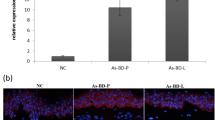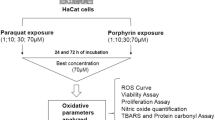Abstract
Arsenic is a naturally occurring element that is present in food, soil, and water. Inorganic arsenic can accumulate in human skin and is associated with increased risk of skin cancer. Oxidative stress due to arsenic exposure is proposed as one potential mode of carcinogenic action. The purpose of this study is to investigate the specific reactive oxygen and nitrogen species that are responsible for the arsenic-induced oxidative damage to DNA and protein. Our results demonstrated that exposure of human keratinocytes to trivalent arsenite caused the generation of 8-hydroxyl-2′-deoxyguanine (8-OHdG) and 3-nitrotyrosine (3-NT) in a concentration- and time-dependent manner. Pentavalent arsenate had similar effects, but to a significantly less extent. The observed oxidative damage can be suppressed by pre-treating cells with specific antioxidants. Furthermore, we found that pre-treating cells with Nω-nitro-l-arginine methyl ester (l-NAME), an inhibitor of nitric oxide synthase (NOS), or with 5,10,15,20-tetrakis (N-methyl-4′-pyridyl) porphinato iron (III) chloride (FeTMPyP), a decomposition catalyst of peroxynitrite, suppressed the generation of both 8-OHdG and 3-NT, which indicated that peroxynitrite, a product of the reaction of nitric oxide and superoxide, played an important role in arsenic-induced oxidative damage to both DNA and protein. These findings highlight the involvement of peroxynitrite in the molecular mechanism underlying arsenic-induced human skin carcinogenesis.
Similar content being viewed by others
References
Edelman P: Environmental and workplace contamination in the semiconductor industry: Implications for future health of the workforce and community. Environ Health Perspect 86: 291–295, 1990
Shannon RL, Strayer DS: Arsenic-induced skin toxicity. Human Toxicol 8: 99–104, 1989
Norton W, Dunnette D: Health effects of environmental arsenic. Wiley and Sons, Inc., 1994
Schwartz RA: Premalignant keratinocytic neoplasms. J Am Ac Dermatol 35: 223–242, 1996
Schwartz RA: Arsenic and the skin. Int J Dermatol 36: 241–250, 1997
Shi H, Hudson LG, Ding W, Wang SW, Copper KL, Liu SM, Shi XL, Liu KJ: Arsenite causes DNA damage in keratinocytes via generation of hydroxyl radicals. Chem Res Toxicol 17: 871–878, 2004
Marnett LJ: Oxyradicals and DNA damage. Carcinogenesis 21: 361–370, 2000
Denissenko MF, Pao A, Tang M, Pfeifer G.P: Preferential formation of benzo[α]pyrene adducts at lung cancer mutational hotspots in p53. Science 274: 430–432, 1996
Colapietro AM, Goodell AL, Smart RC: Characterization of benzo- [α]pyrene-initiated mouse skin papillomas for Ha-ras mutations and protein kinase C levels. Carcinogenesis 14: 2289–2295, 1993
Helbock HJ, Beckman KB, Ames BN: 8-hydroxydeoxyguanosine and 8-hydroxyguanine as biomarkers of oxidative DNA damage. Meth Enzymol 300: 156–166, 1999
Haddad IY, Zhu S, Ischiropoulos H, Matalon S: Nitration of surfactant protein A results in decreased ability to aggregate lipids. Am J Physiol Lung Cell Mol Physiol 270: L281–L288, 1996
MacMillian-Crow LA, Crow JP, Kerby JD, Beckman JS, Thomson JA: Nitration and inactivation of manganese superoxide dismutase in chronic rejection of human renal allografts. Proc Natl Acad Sci USA 93: 11853–11858, 1996
Zhu S, Haddad IY, Matalon S: Nitration of surfactant protein A (SP-A) tyrosine residues results in decreased mannose binding ability. Arch Biochem Biophys 333: 282–290, 1996
Crow JP, Ye YZ, Strong M, Kirk M, Barnes S, Beckman JS: Superoxide dismutase catalyzes nitration of tyrosines by peroxynitrite in the rod and head domains of neurofilament-L. J Neurochem 69: 1945–1953, 1997
Kessel M, Liu SX, Xu A, Santella R, Hei TK: Arsenic induces oxidative DNA damage in mammalian cells. Mol Cell Biochem 234/235: 301–308, 2002
Crow JP: Measurement and significance of free and protein-bound 3-nitrotyrosine, 3-chlorotyrosine, and free 3-nitro-4-hydroxyphenylacetic acid in biologic samples: a high-performance liquid chromatography method method using electrochemical detection. Meth Enzymol 301: 151–160, 1999
Ames BN, Shigenaga MK, Hagen TM: Oxidants, antioxidants, and the degenerative diseases of aging. Proc Natl Acad Sci USA 90: 7915–7922, 1993
Dizdaroglu M: Oxidative damage to DNA in mammalian chromatin. Mutat Res 275: 331–342, 1992
Berlett BS, Friguet B, Yim MB, Chock PB, Stadman ER: Peroxynitrite-mediated nitration of tyrosine residues in Escherichia coli glutamine synthetase mimics adenylylation: relevance to signal transduction. Proc Natl Acad Sci USA 93: 1776–1780, 1996
Kong SK, Yim MB, Stadtman ER, Chock PB: Peroxynitrite disables the tyrosine phosphorylation regulatory mechanism: Lymphocyte-specific tyrosine kinase fails to phosphorylate nitrated cdc2(6–20)NH2 peptide. Proc Nal Acad Sci USA 93: 3377–3382, 1996
Zhang P: The use of arsenic trioxide (As2O3) in the treatment of acute promyelocytic leukemia. J Biol Regul Homeost Agents 13: 195–200, 1999
NRC: National Research Council Report: Arsenic in the drinking water, National Academy Press, Washington, DC, 2001, pp 6975–7066
Kitchin KT: Recent advances in arsenic carcinogenesis: modes of action, animal model system, and methylated arsenic metabolites. Toxicol Appl Pharmacol 172: 249–261, 2001
Wiseman H, Halliwell B: Damage to DNA by reactive oxygen and nitrogen species: Role in inflammatory disease and progression to cancer. Biochem J 313: 17–29, 1996
Liu F, Jan KY: DNA damage in arsenite- and cadmium-treated bovine aortic endothelial cells. Free Radic Biol Med 28: 55–63, 2000
Kim HW, Murakami A, Williams MV, Ohigashi H: Mutagenicity of reactive oxygen and nitrogen species as detected by co-culture of activated inflammatory leukocytes and AS52 cells. Carcinogenesis 24: 235–241, 2003
Hattori Y, Nishigori C, Tanaka T, Uchida K, Nikaido O, Osawa T, Hiai H, Iamnura S, Toyokuni S: 8-hydroxy-2′-deoxyguanosine is increased in epidermal cells of hairless mice after chronic ultraviolet B exposure. J Invest Dermatol 107: 733–737, 1997
Xie Z, Wei M, Morgan TE, Fabrizio P, Han Derick, Finch CE, Longo VD: Peroxynitrite mediates neurotoxicity of amyloid β-peptide1−42 and lipopolysaccharide-activated microglia. J Neurosci 22: 3484–3492, 2002
Nagle MR, Cotter MA, Caneron NE: Effects of peroxynitrite decomposition catalyst, FeTMPyP, on function of corpus cavernosum from diabetic mice. Eur J Pharmacol 502: 143–148, 2004
Sharma SS, Munusamy S, Thiyagarajan M, Kaul CL: Neuroprotective effect of peroxynitrite decomposition catalyst and poly(adenosine diphosphate-ribose) polymerase inhibitor alone and in combination in rats with focal cerebral ischemia. J Neurosurg 101: 669–675, 2004
Chattophadhyay S, Bhaumik S, Chrudhury AN, DasGupta S: Arsenic induced changes in growth development and apoptosis in neonatal and adult brain cells in vivo and in tissue culture. Toxicol Lett 128: 73–84, 2002
Kao YH, Yu CL, Chang LW, Yu HS: Low concentrations of arsenic vascular endothelial growth factor and nitric oxide release and stimulate angiogenesis in vitro. Chem Res Toxicol 16: 460–468, 2003
Bunderson M, Coffin JD, Beall HD: Arsenic induces peroxynitrite generation and cyclooxygenase-2 protein expression in aortic endothelial cells: possible role in atherosclerosis. Toxicol Appl Pharmacol 184: 11–18, 2002
Waalkes MP, Keeper LK, Diwan BA: Induction of proliferative lesions of the uterus, testes, and liver in Swiss mice given repeated injections of sodium arsenate: Possible estrogenic mode of action. Toxicol Appl Pharmacol 166: 24–35, 2000
Souza K, Maddock, DA, Zhang Q, Chen J, Chiu C, Mehta S, Wan Y: Arsenite activation of P13/AKT cell survival pathway is mediated by p38 in culture human keratinocytes. Mol Med 7: 767–772, 2001
Pi J, Kumagai Y, Sun G, Uamauchi H, Yoshida T, Iso H, Endo A, Yu L, Yuki K, miyauchi T, Shimojo N: Decreased serum concentrations of nitric oxide metabolites among Chinese in an endemic area of chronic arsenic poisoning in inner Mongolia. Free Radic Biol Med 28: 1137–1142, 2000
Wong HR: Expression of iNOS in cultured rat pulmonary artery smooth muscle cells is inhibited by the heat shock response. Am J Physiol 269: L843–L848, 1995
Barchowsky A, Klei LR, Dudek EJ, Swartz HM, James PE: Stimulation of reaction oxygen, but not reactive nitrogen species, in vascular endothelial cells exposed to low levels of arsenite. Free Radic Biol Med 27: 1405–1412, 1999
Christodoulides N: Vascular smooth muscle cell heme oxygenases generate guanylyl cyclase-stinulatory carbon monoxide. Circulation 91: 2306–2309, 1995
Peraza MA, Carter DE, Gandolfi AJ: Toxicity and metabolism of subcytotoxicity inorganic arsenic in human renal proximal tubule epithelial cells (HK-2). Cell Biol Toxicol 19: 253–264, 2003
Author information
Authors and Affiliations
Corresponding author
Rights and permissions
About this article
Cite this article
Ding, W., Hudson, L.G. & Liu, K.J. Inorganic arsenic compounds cause oxidative damage to DNA and protein by inducing ROS and RNS generation in human keratinocytes. Mol Cell Biochem 279, 105–112 (2005). https://doi.org/10.1007/s11010-005-8227-y
Issue Date:
DOI: https://doi.org/10.1007/s11010-005-8227-y




